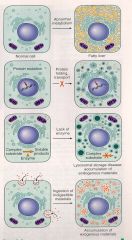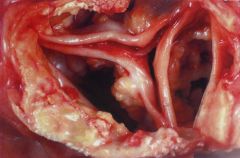![]()
![]()
![]()
Use LEFT and RIGHT arrow keys to navigate between flashcards;
Use UP and DOWN arrow keys to flip the card;
H to show hint;
A reads text to speech;
21 Cards in this Set
- Front
- Back
|
4 cores of pathology |
1. cause(etiology) 2. mechanisms of its development(pathogenesis) 3. biochemical & structural alterations induced in cells & organs of the body(molecular & morphologic changes) 4. functional consequences of changes(clinical manifestation) |
|
|
세포 적응 |
1. 비대(hypertrophy); increase in size of cells 2. 증식(hyperplasia); increase in the number of cells 3. 위축(atropy): decrease in size & metabolic activity of cells 4. metaplasia: change in phenotype of cells |
|
|
1. 비대(hypertrophy) |
세포의 structural component의 합성 증가에 의해 세포 크기가 커진 것으로 결국 장기가 커진다. 원인-기능 부하의 증가, 호르몬과 성장 인자의 자극 physiologic-임신 중 자궁, 운동으로 인한 근육 크기 증가 pathologic-만성고혈압 환자의 심근 세포 selective hypertrophy of subcellular organelle-barbiturate으로 인한 간세포내 sER 비대로 해독효소 증가 |
|
|
2. 증식(hyperplasia) |
조직이나 장기의 세포 수가 많아지는 것이며, 조직이나 장기가 커진다. 증식과 비대가 같이 일어나는 경우 많음 원인-호르몬과 성장 인자의 자극 physiologic-사춘기의 유방 샘상피 증식, 간의 compensatory증식 pathologic- (1)에스트로겐 과잉에 의한 자궁내막 선의 병적 증식-자궁 내막암의 토양 (2) BPH(안드로겐 과잉) (3)wart(virus에 의한 성장인자로 상피 증식) |
|
|
3. 위축(atrophy) |
세포의 크기와 수가 감소, 조직이나 장기의 크기가 작아진다. 원인-metabolic activity 감소에 의한 세포 내 단백합성 감소와 단백 분해 증가 physiologic-분만 후 자궁 크기 감소, 폐경기 후 자궁내막 크기 감소 |
|
|
pathologic atrophy? |
1. decreased workload(disuse atrophy) -complete bed rest --> sk. ms atrophy 2. loss of innervation(denervation atrophy)-atrophy of ms fiber 3. diminished blood supply: brain atrophy in atherosclerosis(뇌졸중. 치매) cf. physiologic: 나이가 들어서 brain atrophy 4. inadequate nutrition: sk. ms atrophy for energy source 5. loss of endocrine stimulation 6. pressure |
|
|
4. 화생(metaplasia) |
성숙 세포가 다른 종류의 성숙 세포로 바뀌는 가역적(stress 없어지면 다시 원래로) 변화 특정 스트레스에 대해 감수성을 가진 세포가 내성을 가져 손상을 적게 받는 세포로 바뀜 상피조직의 줄기세포나 결합조직의 미분화줄기세포가 유전자를 재프로그램시켜 나타난다. 바람직하지 않은 변화로 기관지암 자궁경부암 발생 |
|
|
화생의 예시 3가지? |
1. 기관지암 -ciliated single columnar cell -> stratified squamous cell (점액 분비기능 상실) -담배연기 노출, 비타민 A 결핍된 기관지 점막 -침샘, 췌장, 담관의 결석 2. 식도암 squamous cell -> columnar cell -식도와 위의 경계(GE junction)이 tight하게 닫혀있지 않은 경우 위산이 식도를 자극하여 barrett esophagus --> barrett adenocarcinoma 3. 결합조직 화생(intramuscular hemorrhage) 근육 내에 골조직이 생기는 myositis ossificans |
|
|
세포 내 축적(intracellular accumulation) 4가지? |
원인: 세포 내 대사 장애 1. 정상적인 내부물질의 대사율이 부적절(물질 생성은 정상 or 증가) : 간의 지방 변화(steatosis) 2. 정상적인 내부물질이 대사에 필요한 효소의 결손으로 축적: 알파1항트립신 결핍증 3. 유전자 변이로 정상적인 내부물질이 만들어지지 못하고 비정상적인 내부물질이 축적: lysosomal storage disease 4. 비정상적 외인성 물질이 분해되지 못하거나 다른 장소로 운반되지 못하여 침착 or 축적: carbon particle이나 silica의 축적 |
|
|
세포 내 축적되는 물질의 종류 4개 |

1. lipid 2. protein 3. glycogen 4. pigments 일과성 or 가역적 vs 영구적 or 세포사 |
|
|
lipid 축적이 잘되는 곳 4군데? |
간. 심장, 근육, 신장(parenchyme)갖고 있는 장기 not lung!!!!! |
|
|
steatosis란? |
-실질 세포 내에 triglyceride가 비정상적으로 축적된 가역적 변화 -심장은 빈혈 등으로 인한 중등도의 지속성 저산소증으로 호랑이가죽같은 얼룩무늬 |
|
|
간의 지방변화 병인 6개? |
1. 기아: 지방조직에서 지방산 유리 증가 -> 간의 지방산 흡수 증가 2. 간세포에 있는 초산염(acetate)에서 지방산 합성 증가 3. 알코올, 무산소증 -> 지방산의 산화 감소 4. alpha-glycerophosphate 증가에 의한 TG 형성 증가 5. apoprotein 합성 감소: 사염화탄소 중독, 단백질 부족 6. lipoprotein 분비 장애 |
|
|
cholesterol (ester)의 축적 |
1. 죽상 동맥 경화증(atheroscleoris): 동맥의 평활근 세포와 대식 세포 내 축적 2. 황색종(xanthoma) : 세포질이 거품처럼 보이는 foamy cell(intracellular accumulation of cholesterol w/in macrophages)이 GI tract, skin 등에 3. cholesterolosis: 담낭 점막 내 cholesterol-laden macrophage의 군집, 백인에 많음 4. niemann-Pick disease, type C: 콜레스테롤 대사과정의 효소 장애, lysosomal storage disease,유대인에 많음 |
|
|
protein의 축적 |
1. kidney prox. tubule reabsroption droplet: 가역적 단백뇨 -pink hyaline droplet 2. russell body: plasma cell에 immunoglobullin 축적 ER becomes hugely distened, large homogeneous eosinophilic inclusions 3. defective intracellular transport & secretion of critical proteins: alpha1 antitrypsin deficiency -중간단계의 단백질이 쌓임 4. cytoskeletal protein의 축적 -alcoholic hyaline(keratin filament) in alcoholic liver disease 5. 비정상 단백질의 응집: amyloidosis |
|
|
glycogen의 축적 원인 병 2가지? |
-포도당이나 글리코겐 대사 이상으로 세포질내 clear vacuole로 나타남 1. 당뇨병: 신세관 상피세포(renal tubular epithelial cell), 간세포, 심근세포, beta cell of islet of langerhans 2. 글리코겐 축적 질환: 대사가 안되서 세포손상, 세포사(glycogenoses) |
|
|
pigment의 축적 |
1. 외부 색소 (1)문신: 진피의 대식세포에 탐식(phagocytosed by dermal macrophage) (2)탄소, 탄분: 흡입되어 폐포의 대식세포에 탐식 2. 내부 색소 (1) lipofuscin: 노화 (2) hemosiderin: hemorrage, RBC 깨져서 분해, 축적 (3) bilibrubin: 돌로 간에 축적 (4) melanin: melanin 생성 세포의 hyperplasia |
|
|
병적 석회화(pathologic calcification) 2가지? |
1. 퇴행성(dystrophic calcification)-deposit occur in dead or dying tissues(histocyte(scavenger 역할의 macrophage in 조직이 다 못잡아먹어서) w/o derangement in calcium metabolism(serum의 칼슘 레벨이 정상) 2. 전이성(metastatic calcification) -deposit in normal tissue, secondary함(hypercalcemia) |
|
|
퇴행석 석회화 |

괴사 조직-손상된 심장 판막 석회화로 판막 기능장애 육안:fine, white granule or clump |
|
|
전이성 석회화 |
뼈를 분해해서 hypercalcemia 육안적으로는 퇴행성 석회화와 유사 일반적으로 기능장애 없지만, 폐가 심하게 되면 호흡장애, 신장에 대량 되면 신장 손상 |
|
|
cellular aging(노화)의 원인 4가지? |
1. deceased cellular replication-telomere가 짧아지면서 but telomere길다고 수명이 길지 않다 2. accumulation of genetic change: ROS 3. defective protein homeostasis: proteasome문제 4. nutrient sensing system : calorie restriction하면 오래 산다 |

